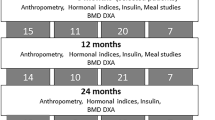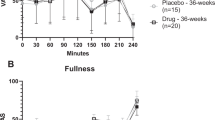Abstract
PURPOSE: Hyperinsulinemia is a common feature of many obesity syndromes. We investigated whether suppression of insulin secretion, without dietary or exercise intervention, could promote weight loss and alter food intake and preference in obese adults.
METHODS: Suppression of insulin secretion was achieved using octreotide-LAR 40 mg IM q28d for 24 weeks in 44 severely obese adults (89% female, 39% minority). Oral glucose tolerance testing was performed before and after treatment, indices of β-cell activity (CIRgp), insulin sensitivity (CISI), and clearance (CP/I AUC) were computed, and leptin levels, 3-day food records and carbohydrate-craving measurements were obtained. DEXA evaluations were performed pre- and post-therapy in an evaluable subgroup.
RESULTS: For the entire cohort, significant insulin suppression was achieved with simultaneous improvements in insulin sensitivity, weight loss, and body mass index (BMI). Leptin, fat mass, total caloric intake, and carbohydrate craving significantly decreased. When grouped by BMI response, high responders (HR; ΔBMI<−3 kg/m2) and low responders (LR; ΔBMI between −3 and −0.5) exhibited higher suppression of CIRgp and IAUC than nonresponders (NR; ΔBMI−0.5). CISI improved and significant declines in leptin and fat mass occurred only in HR and LR. Conversely, both leptin and fat mass increased in NR. Carbohydrate intake was markedly suppressed in HR only, while carbohydrate-craving scores decreased in HR and LR. For the entire cohort, ΔBMI correlated with ΔCISI, Δfat mass, and Δleptin. ΔFat mass also correlated with ΔIAUC and ΔCISI.
CONCLUSIONS: In a subcohort of obese adults, suppression of insulin secretion was associated with loss of body weight and fat mass and with concomitant modulation of caloric intake and macronutrient preference.
This is a preview of subscription content, access via your institution
Access options
Subscribe to this journal
Receive 12 print issues and online access
$259.00 per year
only $21.58 per issue
Buy this article
- Purchase on Springer Link
- Instant access to full article PDF
Prices may be subject to local taxes which are calculated during checkout


Similar content being viewed by others
References
Kuczmarski RJ, Flegal KM, Campbell SM, Johnson CL . Increasing prevalence of overweight among US adults. The National Health and Nutrition Examination Surveys, 1960 to 1991. JAMA 1994; 272: 205–211.
Mokdad AH, Serdula MK, Dietz WH, Bowman BA, Marks JS, Koplan JP . The spread of the obesity epidemic in the United States, 1991–1998. JAMA 1999; 282: 1519–1522.
Luepker RV, Perry CL, McKinlay SM, Nader PR, Parcel GS, Stone EJ, Webber LS, Elder JP, Feldman HA, Johnson CC et al. Outcomes of a field trial to improve children's dietary patterns and physical activity. The Child and Adolescent Trial for Cardiovascular Health. CATCH collaborative group. JAMA 1996; 275: 768–776.
Skender ML, Goodrick GK, Del Junco DJ, Reeves RS, Darnell L, Gotto AM, Foreyt JP . Comparison of 2-year weight loss trends in behavioral treatments of obesity: diet, exercise, and combination interventions. J Am Diet Assoc 1996; 96: 342–346.
Bray GA, Gray DS . Treatment of obesity: an overview. Diabetes Metab Rev 1988; 4: 653–679.
Lillioja S, Nyomba BL, Saad MF, Ferraro R, Castillo C, Bennett PH, Bogardus C . Exaggerated early insulin release and insulin resistance in a diabetes-prone population: a metabolic comparison of Pima Indians and Caucasians. J Clin Endocrinol Metab 1991; 73: 866–876.
Haffner SM, D'Agostino R, Saad MF, Rewers M, Mykkanen L, Selby J, Howard G, Savage PJ, Hamman RF, Wagenknecht LE, Bergman RN . Increased insulin resistance and insulin secretion in nondiabetic African-Americans and Hispanics compared with non-Hispanic whites. The Insulin Resistance Atherosclerosis Study. Diabetes 1996; 45: 742–748.
Marin P, Rebuffe-Scrive M, Smith U, Bjorntorp P . Glucose uptake in human adipose tissue. Metabolism 1987; 36: 1154–1160.
Ramsay TG . Fat cells. Endocrinol Metab Clin North Am 1996; 25: 847–870.
Taylor SI, Accili D, Imai Y . Insulin resistance or insulin deficiency. Which is the primary cause of NIDDM? Diabetes 1994; 43: 735–740.
Sigal RJ, El-Hashimy M, Martin BC, Soeldner JS, Krolewski AS, Warram JH . Acute postchallenge hyperinsulinemia predicts weight gain: a prospective study. Diabetes 1997; 46: 1025–1029.
Le Stunff C, Bougneres P . Early changes in postprandial insulin secretion, not in insulin sensitivity, characterize juvenile obesity. Diabetes 1994; 43: 696–702.
Brandes JS . Insulin induced overeating in the rat. Physiol Behav 1977; 18: 1095–1102.
Cohen P, Barzilai N, Barzilai D, Karnieli E . Correlation between insulin clearance and insulin responsiveness: studies in normal, obese, hyperthyroid, and Cushing's syndrome patients. Metabolism 1986; 35: 744–749.
Weiner MF . Rapid weight gain due to overinsulinization. Obes Bariatric Med 1980; 9: 118–119.
Woods WC, Decke E, Vasselli JR . Metabolic hormones and regulation of body weight. Physiol Rev 1974; 81: 26–43.
Odeleye OE, de Courten M, Pettitt DJ, Ravussin E . Fasting hyperinsulinemia is a predictor of increased body weight gain and obesity in Pima Indian children. Diabetes 1997; 46: 1341–1345.
Zannolli R, Rebeggiani A, Chiarelli F, Morgese G . Hyperinsulinism as a marker in obese children. Am J Dis Child 1993; 147: 837–841.
Tokunaga K, Fukushima M, Kemnitz JW, Bray GA . Effect of vagotomy on serum insulin in rats with paraventricular or ventromedial hypothalamic lesions. Endocrinology 1986; 119: 1708–1711.
Inoue S, Bray GA . The effects of subdiaphragmatic vagotomy in rats with ventromedial hypothalamic obesity. Endocrinology 1977; 100: 108–114.
Bray GA, York DA . Hypothalamic and genetic obesity in experimental animals: an autonomic and endocrine hypothesis. Physiol Rev 1979; 59: 719–809.
Bray GA . Syndromes of hypothalamic obesity in man. Pediatr Ann 1984; 13: 525–536.
Sklar CA . Craniopharyngioma: endocrine sequelae of treatment. Pediatr Neurosurg 1994; 21 (Suppl 1): 120–123.
Lustig RH, Rose SR, Burghen GA, Velasquez-Mieyer P, Broome DC, Smith K, Li H, Hudson MM, Heideman RL, Kun LE . Hypothalamic obesity caused by cranial insult in children: altered glucose and insulin dynamics and reversal by a somatostatin agonist. J Pediatr 1999; 135: 162–168.
Guven S, El-Bershawi A, Sonnenberg GE, Wilson CR, Hoffmann RG, Krakower GR, Kissebah AH . Plasma leptin and insulin levels in weight-reduced obese women with normal body mass index: relationships with body composition and insulin. Diabetes 1999; 48: 347–352.
Heller RF, Heller RF . Are you a carbohydrate craver? The carbohydrate addict's diet. Signet, New York, NY. 1991.
Reaven GM, Brand RJ, Chen YD, Mathur AK, Goldfine I . Insulin resistance and insulin secretion are determinants of oral glucose tolerance in normal individuals. Diabetes 1993; 42: 1324–1332.
ADA. Report of the expert committee on the diagnosis and classification of diabetes mellitus. Diabetes Care 1997; 20: 1183–1197.
Kadish AH, Little RH, Sternberg JC . A new and rapid method for the determination of glucose by measurement of rate of oxygen consumption. Clin Chem 1968; 14: 116–119.
Toft I, Bonaa KH, Lindal S, Jenssen T . Insulin kinetics, insulin action, and muscle morphology in lean or slightly overweight persons with impaired glucose tolerance. Metabolism 1998; 47: 848–854.
Tallarida RJ, Murray RB . Manual of pharmacologic calculations with computer programs. Springer-Verlag: New York, 1986. pp 77–81.
Sluiter WJ, Erkelens DW, Terpstra P, Reitsma WD, Doorenbos H . Glucose tolerance and insulin release, a mathematical approach. II. Approximation of the peripheral insulin resistance after oral glucose loading. Diabetes 1976; 25: 245–249.
Matsuda M, DeFronzo RA . Insulin sensitivity indices obtained from oral glucose tolerance testing: comparison with the euglycemic insulin clamp. Diabetes Care 1999; 22: 1462–1470.
Meistas MT, Margolis S, Kowarski AA . Hyperinsulinemia of obesity is due to decreased clearance of insulin. Am J Physiol 1983; 245: E155–E159.
Williams C, Gowan R, Perey BJ . A double-blind placebo-controlled trial of ursodeoxycholic acid in the prevention of gallstones during weight loss after vertical banded gastroplasty. Obes Surg 1993; 3: 257–259.
Alemzadeh R, Langley G, Upchurch L, Smith P, Slonim AE . Beneficial effect of diazoxide in obese hyperinsulinemic adults. J Clin Endocrinol Metab 1998; 83: 1911–1915.
Gordon DF, Woodmansee WW, Lewis SR, James RA, Wood WM, Ridgway EC . Cloning of the mouse somatostatin receptor subtype 5 gene: promoter structure and function. Endocrinology 1999; 140: 5598–5608.
Mitra SW, Mezey E, Hunyady B, Chamberlain L, Hayes E, Foor F, Wang Y, Schonbrunn A, Schaeffer JM . Colocalization of somatostatin receptor sst5 and insulin in rat pancreatic beta-cells. Endocrinology 1999; 140: 3790–3796.
Lunetta M, Di Mauro M, Le Moli R, Burrafato S . Long-term octreotide treatment reduced hyperinsulinemia, excess body weight and skin lesions in severe obesity with acanthosis nigricans. J Endocrinol Invest 1996; 19: 699–703.
Giustina A, Girelli A, Buffoli MG, Cimino A, Legati F, Valentini U, Giustina G . Low-dose octreotide is able to cause a maximal inhibition of the glycemic responses to a mixed meal in obese type 2 diabetic patients treated with insulin. Diabetes Res Clin Pract 1991; 14: 47–54.
Bertoli A, Magnaterra R, Borboni P, Marini MA, Barini A, Fusco A, Bollea MR . Dose-dependent effect of octreotide on insulin secretion after OGTT in obesity. Horm Res 1998; 49: 17–21.
Simsolo RB, Ezzat S, Ong JM, Saghizadeh M, Kern PA . Effects of acromegaly treatment and growth hormone on adipose tissue lipoprotein lipase. J Clin Endocrinol Metab 1995; 80: 3233–3238.
Lotter EC, Krinsky R, McKay JM, Treneer CM, Porter Jr D, Woods SC . Somatostatin decreases food intake of rats and baboons. J Comp Physiol Psychol 1981; 95: 278–287.
Levine AS, Morley JE . Peripherally administered somatostatin reduces feeding by a vagal mediated mechanism. Pharmacol Biochem Behav 1982; 16: 897–902.
Campbell RM, Scanes CG . Inhibition of growth hormone-stimulated lipolysis by somatostatin, insulin, and insulin-like growth factors (somatomedins) in vitro. Proc Soc Exp Biol Med 1988; 189: 362–366.
Jimenez J, Zuniga-Guajardo S, Zinman B, Angel A . Effects of weight loss in massive obesity on insulin and C-peptide dynamics: sequential changes in insulin production, clearance, and sensitivity. J Clin Endocrinol Metab 1987; 64: 661–668.
Hansen TB, Gram J, Bjerre P, Hagen C, Bollerslev J . Body composition in active acromegaly during treatment with octreotide: a double-blind, placebo-controlled cross-over study. Clin Endocrinol (Oxf) 1994; 41: 323–329.
Adami GF, Gandolfo P, Scopinaro N . Binge eating in obesity. Int J Obes Relat Metab Disord 1996; 20: 793–794.
Blum I, Nessiel L, Graff E, Harsat A, Gabbay U, Sulkes J, Raz O, Vered Y . Food preferences, body weight, and platelet-poor plasma serotonin and catecholamines. Am J Clin Nutr 1993; 57: 486–489.
Hsu LK, Betancourt S, Sullivan SP . Eating disturbances before and after vertical banded gastroplasty: a pilot study. Int J Eat Disord 1996; 19: 23–34.
Peiris AN, Mueller RA, Smith GA, Struve MF, Kissebah AH . Splanchnic insulin metabolism in obesity. Influence of body fat distribution. J Clin Invest 1986; 78: 1648–1657.
Acknowledgements
The work was supported in part by University of Tennessee GCRC 5M01RR 00211, and by a research grant from Novartis Pharmaceuticals Corporation.
The nurses of the University of Tennessee GCRC for their assistance in the care of these subjects, the staff of the University of Tennessee Obesity Wellness Center for their technical assistance, and Drs Laurie Letvak and Kurt Sizer of Novartis Pharmaceuticals Corp. for their support.
Author information
Authors and Affiliations
Corresponding author
Rights and permissions
About this article
Cite this article
Velasquez-Mieyer, P., Cowan, P., Arheart, K. et al. Suppression of insulin secretion is associated with weight loss and altered macronutrient intake and preference in a subset of obese adults. Int J Obes 27, 219–226 (2003). https://doi.org/10.1038/sj.ijo.802227
Received:
Revised:
Accepted:
Published:
Issue Date:
DOI: https://doi.org/10.1038/sj.ijo.802227
Keywords
This article is cited by
-
Effects of dietary-based weight loss interventions on biomarkers of endothelial function: a systematic review and meta-analysis
European Journal of Clinical Nutrition (2023)
-
Metabolic actions of the growth hormone-insulin growth factor-1 axis and its interaction with the central nervous system
Reviews in Endocrine and Metabolic Disorders (2022)
-
On the causal relationships between hyperinsulinaemia, insulin resistance, obesity and dysglycaemia in type 2 diabetes
Diabetologia (2021)
-
Early beta cell dysfunction vs insulin hypersecretion as the primary event in the pathogenesis of dysglycaemia
Diabetologia (2020)
-
Insulin translates unfavourable lifestyle into obesity
BMC Medicine (2018)



